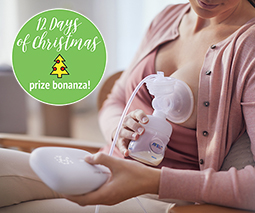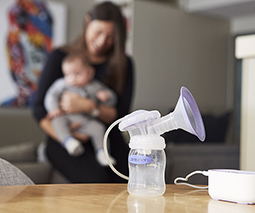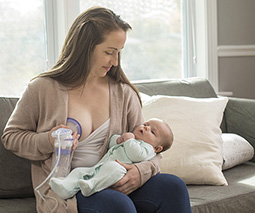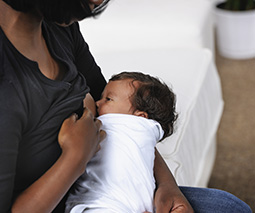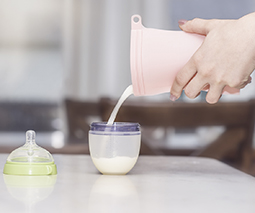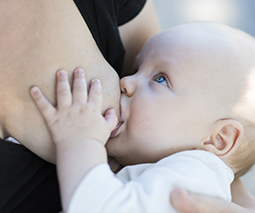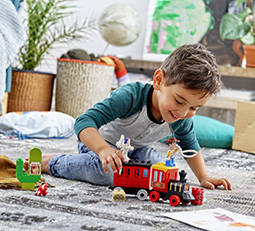Everything you need to know about expressing and storing breastmilk

I’m a huge advocate of expressing breastmilk. I did it while breastfeeding both of my children for a multitude of reasons – sore nipples, forceful letdown, mastitis, surgery, nipple thrush, so I could have more than 45 minutes sleep … you name it.
I became an expert expresser. But at the start I was all at sea; I didn’t have a clue what I was doing, particularly when it came to storing breastmilk. If you’re in the same boat, take a look at this handy guide that we’ve put together.
What you need
You can hand express, and this is a good way to get relief from engorged breasts, however if you plan to express regularly to store feeds, your best option is to purchase a breast pump. There are manual breast pumps that don’t require electricity, and electric pumps that do all the work for you and allow you to express quickly, which is ideal if you are expressing regularly.
However you choose to express, the breast pump you use should make expressing a cinch. The key is to make sure you’re relaxed and comfortable, just as you would be if you were breastfeeding. If you’re at work, it may help to look at a picture of your baby to help with let down.
You’ll also need something to store the milk once it’s expressed. Of course, you can express directly into a baby’s bottle if your breast pump is designed to attach to one. You can also store your breast milk in special milk storage bags – which have a zip lock double seal, and have already been sterilised.
Handy hint: keep a towel within arm’s reach to wipe up any drips when you finish. Sometimes even though you’ve finished expressing, your breasts won’t be done yet!
How it works
Before you express, make sure all of your equipment has been sterilised and wash your hands. And of course, once you’re finished everything will need to be sterilised again. Basically, when you first place the cushion part of the breast pump onto your nipple, use the stimulation mode to help your milk start flowing – the same way a baby vigorously sucks to initiate let-down. Once you can see that the milk is flowing through the funnel and into the bottle or storage bag, then you can adjust the mode to suit. Make sure it feels comfortable, and try to relax!
When I was expressing, I tried to gauge the amount of time by how long my baby would normally feed, rather than how much milk was in the bottle. You’ll find that at different times of day, you’ll have different amounts of milk. For instance, first thing in the morning you may be able to express quite a lot, particularly if it’s been a while since your baby fed.
Breastmilk storage
Whether you use milk storage bags or bottles to store your milk, there are some rules you’ll need to follow.
- You can store freshly expressed breastmilk at room temperature (26°C or lower) for six to eight hours.
- If you’re not using the breastmilk in that timeframe, it should be put in the fridge or freezer.
- It can be stored in the fridge for up to 72 hours (a good tip is to pop it towards the back of the fridge where it’s the coldest).
- Breastmilk can be kept in the freezer compartment inside a fridge for two weeks.
- It can be stored in the freezer section of a fridge, with a separate door, for up to three months.
- You can keep breastmilk in the deep freeze (-18°C or lower) for between six and 12 months.
- You can thaw frozen breastmilk by holding the bag or bottle under running warm water, or sitting it in a cup of warm water.
- Frozen breastmilk that has been thawed in the fridge (but not warmed) can be kept at room temperature for up to four hours, and in the fridge for up to 24 hours. Do not refreeze this milk.
- If you’ve thawed frozen breastmilk in warm water, you can keep it at room temperature until the end of the feed, or in the fridge for up to four hours.
- When you store your breast milk, you’ll notice that it separates into two layers – with the cream on top, so make sure you swirl the milk around once warmed.
When to express
This is completely up to you. Some mums like to express after the first morning feed, when their breasts are more full; or if their baby feeds from one breast, they’ll express the other. You can also express between nursing, about 45 minutes after feeding. Another time you may like to express is at night after your baby has gone to sleep.
It’s a good idea to have a chat to a lactation consultant for further advice about expressing and storing breastmilk, or you can find lots of useful information at the Australian Breastfeeding Association.
 Need some more feeding advice? Our Parent School lactation experts can help. Click to find out more or book a one-on-one session.
Need some more feeding advice? Our Parent School lactation experts can help. Click to find out more or book a one-on-one session.

